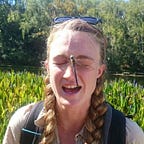Saving the ethereal, magic carpets
“Every dive is an adventure, because you never know what amazing animal you might see below the surface that day,” Michelle Carpenter, a PhD student from Zavora Marine Lab tells me. For her “the most exciting animal to see is a manta ray.”
“Manta” means “cloak” in Spanish and manta rays live up to their namesake of being cloaked in mystical silence. “Imagine an enormous animal shaped like a starship gliding effortlessly and silently through the water.” This image is conjured up by Michelle Carpenter, a PhD student from Zavora Marine Lab as she describes a manta ray to me. “Manta rays truly are enormous; giant manta rays can have an 8m wingspan.” Michelle explains that sometimes, when you’re watching a manta ray, it will come in for a closer look and miss touching you by millimetres. “In these moments,” she says, “it feels like total zen, and sometimes it’s hard for me to remember that I need to be gathering data!”
All this and brains too
Michelle shares that manta rays have the largest brain-to-body-size ratio of any fish, which in the science world is often cited as evidence that signifies intelligence. For instance, humans have the largest brain to body size ratio of any animal. Over and above brain size, there are many behaviours we can observe in manta rays that suggest a high level of intelligence. These include cooperative feeding, breaching as a form of communication, and elaborate courtship displays. For Michelle, behaviour is the most exciting area of research for manta rays, because “it is fascinating and we are just beginning to understand just how intelligent these animals are.”
Michelle describes how these playful, giant, flying-carpets feed on the smallest creatures in the sea — plankton — and are capable of diving to depths of 1400m. She’s wildly passionate about manta rays, and has dedicated the last 4 years of her life to understanding their behaviour, movements, and population structure, to aid the conservation of these ethereal ocean giants.
She explains: “We are living in a very critical but exciting time, facing a plethora of environmental disasters while simultaneously exploring the last unknown realm of the Earth. Research, conservation, and education are all equally important to bring about the change we need to prevent these disasters.”
Trading urban America for a rustic life alongside the ocean
Michelle traded her American life for a rustic, snake and spider-infested treehouse in Mozambique. Mozambique is considered to be the epicentre of manta ray sighting declines.
Michelle got her first lifeguard job at age 15 and immediately began saving to “get to the ocean.” Although a fantastic place to grow up, she knew she didn’t want landlocked Binghamton in central New York State to be her home forever. She forewent a prom dress and other luxuries, choosing instead to save the money she made during high school.
Once out of school, between studies, she continued working multiple jobs including working as a waitress, gardener, landscaper, assistant cook, school teacher, and volunteer. Though drawn to mantas rays throughout her life, it was while volunteering at the Marine Megafauna Foundation that she decided to dedicate her career to protecting and understanding these mystical creatures.
Michelle uses the unique spot patterning on manta rays bellies to identify them individually. She uses photos of manta rays through time to give her information about movement, population numbers, distribution, and habitat use along the east coast of Southern Africa.
I donned my snorkeling gear and jumped in the water with Michelle after our interview. We weren’t lucky enough to see any manta rays, but did see an eagle ray, dolphins, turtles, and ragged-tooth sharks.
Zavora Marine Lab / Marine Action Research
Michelle’s PhD is in association with the University of Cape Town, in South Africa, Zavora Marine Lab, and the Marine Megafauna Foundation Mozambique. Mozambique has seen the greatest decline in manta ray sightings. The Zavora lab specialises in conserving and investigating the unique marine life and coastal ecosystems of Zavora Bay. This remote and pristine area is brimming with marine life, and offers a unique opportunity to study a marine environment that has had little impact from recreational diving activities, and where much of the reef is still unexplored. Zavora Marine Labs research is focused on manta rays, humpback whales, nudibranchs and wreck colonization. They have created software to identify individual manta rays, the discovery of new species of nudibranchs and the establishment of educational programs.
Zavora Marine Labs partners with Wildcards!
New wildcards will been launched to raise funds for Zavora! Each card has a captivating fact-filled story about an individual animal Zavora researches and protects. You will be able to publicly buy one of these wildcards online, which will make you the guardian of that wildcard animal. When you buy a wildcard, you must also set the price you are willing to sell it for. Every month, as the guardian of a wildcard you will give a specified portion of the selling price you set, to that animal’s representative conservation agency, in this case, Zavora. At any point, someone can buy the wildcard from you, at the selling price you specified. When someone buys the wildcard from you they must set a selling price. The new guardian of the wildcard is then responsible for giving the new monthly subscription. And so, the cycle continues the generation of funds.
Wildcards is ecstatic about connecting funders with conservation agencies having a real world impact on the protection of wild animals.
Also read:
Wildcards: an unprecedented means of funding conservation
Follow Wildcards on twitter: @wildcards_world
Follow Wildcards on Facebook: @wildcards.conservation
Join us on Telegram: Telegram
Rio Button
